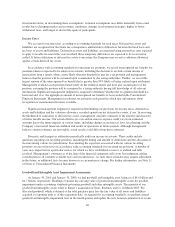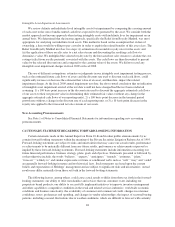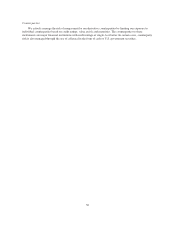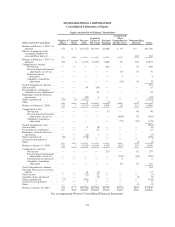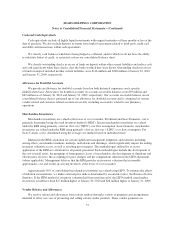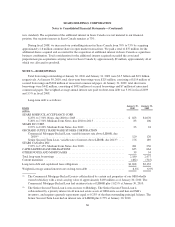Sears 2009 Annual Report Download - page 56
Download and view the complete annual report
Please find page 56 of the 2009 Sears annual report below. You can navigate through the pages in the report by either clicking on the pages listed below, or by using the keyword search tool below to find specific information within the annual report.
SEARS HOLDINGS CORPORATION
Notes To Consolidated Financial Statements
NOTE 1—SUMMARY OF SIGNIFICANT ACCOUNTING POLICIES
Nature of Operations, Consolidation and Basis of Presentation
Sears Holdings Corporation (“Holdings,” “we,” “us,” “our” or the “Company”) is the parent company of
Kmart Holding Corporation (“Kmart”) and Sears, Roebuck and Co. (“Sears”). Holdings was formed as a
Delaware corporation in 2004 in connection with the Merger of Kmart and Sears, which was completed on
March 24, 2005. We are a broadline retailer with 2,235 full-line and 1,284 specialty retail stores in the United
States operating through Kmart and Sears and 402 full-line and specialty retail stores in Canada operating
through Sears Canada Inc. (“Sears Canada”), a 73%-owned subsidiary. We have three reportable segments:
Kmart, Sears Domestic and Sears Canada.
The consolidated financial statements include all majority-owned subsidiaries in which Holdings exercises
control. Investments in companies in which Holdings exercises significant influence, but which we do not control
(generally 20% to 50% ownership interest), are accounted for under the equity method of accounting.
Investments in companies in which we have less than a 20% ownership interest and do not exercise significant
influence are accounted for at cost. All intercompany transactions and balances have been eliminated.
Fiscal Year
Our fiscal year ends on the Saturday closest to January 31st each year. Unless otherwise stated, references to
years in this report relate to fiscal years rather than to calendar years. The following fiscal periods are presented
in this report.
Fiscal year Ended Weeks
2009 .............................................. January 30, 2010 52
2008 .............................................. January 31, 2009 52
2007 .............................................. February 2, 2008 52
Use of Estimates
The preparation of financial statements in conformity with accounting principles generally accepted in the
United States of America requires management to make estimates and assumptions about future events. The
estimates and assumptions affect the reported amounts of assets and liabilities and disclosure of contingent assets
and liabilities at the date of the financial statements, as well as reported amounts of revenues and expenses during
the reporting period. We evaluate our estimates and assumptions on an ongoing basis using historical experience
and other factors that management believes to be reasonable under the circumstances. Adjustments to estimates
and assumptions are made when facts and circumstances dictate. As future events and their effects cannot be
determined with absolute certainty, actual results may differ from the estimates used in preparing the
accompanying consolidated financial statements. Significant estimates and assumptions are required as part of
determining inventory and accounts receivable valuation, estimating depreciation, amortization and
recoverability of long-lived assets, establishing self-insurance, warranty, legal and other reserves, performing
goodwill, intangible and long-lived asset impairment analysis, establishing valuation allowances on deferred
income tax assets and reserves for tax examination exposures, and calculating retirement benefits.
Reclassifications
Certain prior year amounts have been reclassified to conform to the current year presentation.
56


